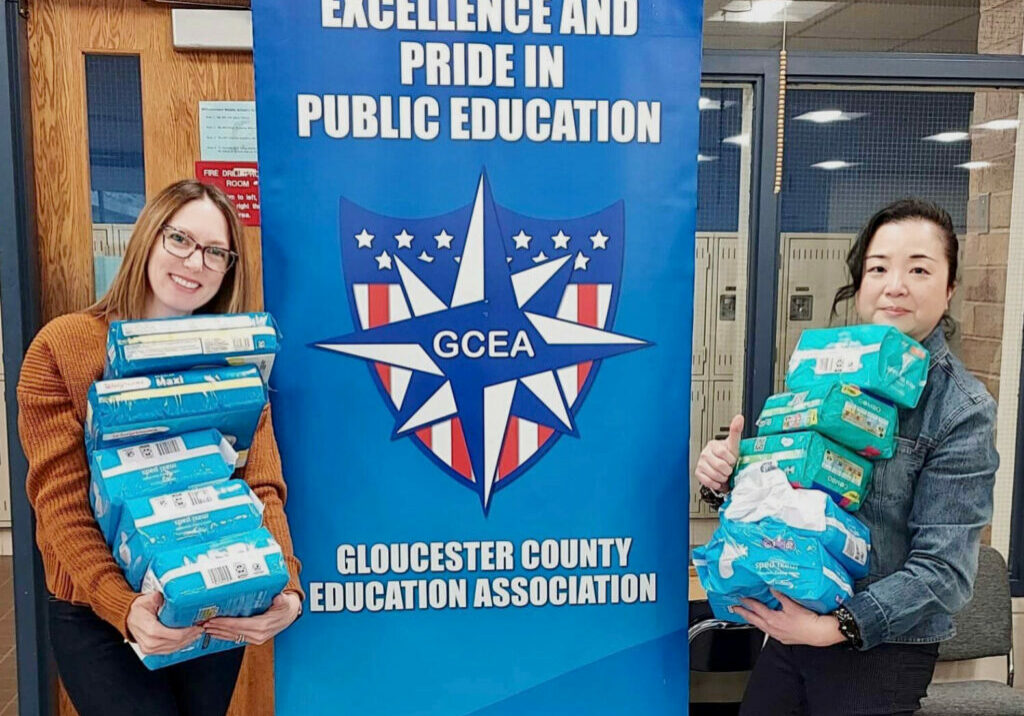By Joyce Farr, Women in Education Committee, GCEA Equity Committee Chair
The Menstrual Movement is not just pivotal but is a priority in the struggle for gender equality.
Period poverty and menstruation are not words heard often in work spaces nor even in our union spaces precisely because one of the most fundamental bodily functions is still a taboo subject. According to Equality, Period, nationally, period poverty affects 22 million people. While lack of access and affordability impacts menstruators statewide and nationally, it has a disproportionate impact on communities of color. Twenty five million women in the country live in poverty, but food stamps do not cover period products.According to a recent study with unsettling findings, one-in-five teens have struggled to afford menstruation products or lack the means to purchase them at all, and one-in-four teens have missed class due to the lack of access to menstrual management products.
This is an equity issue. This is a gender inequality issue.
In the U.S., only 15 states exempt period products from sales tax—California, Connecticut, Florida, Illinois, Maryland, Massachusetts, Minnesota, Nevada, New Jersey, New York, Ohio, Pennsylvania, Rhode Island, Utah and Washington. The rest of the country charge a “pink tax” on what they consider to be “nonessential” goods as though menstrual management products are a luxury. Frankly, it is simply a grievously discriminatory pricing practice based on gender.
My journey in the Menstrual Movement began with almost blissful ignorance of the discrimination and ongoing suffering endured by millions of my sisters. Even my own period tribulations were short lived after I gave up on the idea of childbearing. The average number of days menstruators are on their periods run approximately three to five days, totaling six years of the average menstruator’s lifetime and yet, no where have we adequately address how menstruators are penalized, stigmatized and discriminated against for simply being born with the capability to discharge blood and other materials monthly from the lining of the uterus. Instead, menstruation has been weaponized to subjugate menstruating individuals and even undermine those in power and aspiring leaders. It is a sore point that this subject did not seem to warrant the air time, clickbait-y and catchy headlines on social media platforms nor legislative action until recent years.
I learned about New Jersey’s First Menstrual Health Equity Summit that New Jersey’s First Lady graced in October 2022 after the event. But it awakened the dormant menstrual activist I did not recognize in myself until three book purchases later and a faint memory of an article by a fierce feminist and activist shared with our Women in Education Committee about a piece of legislation that provides menstrual products in schools.
Not all women menstruate, and not all menstruating people are women. Ponder that for a moment. Perhaps like me, you’d never imagine menstruation to be part of political discourse, let alone period poverty and intersectional gender equality.
According to N. Okamoto in Period Power- A Manifesto for the Menstrual Movement, “In the women’s movement we are seeing more inclusivity being stressed, in order to avoid whitewashed feminism and there are conversations to be had in breaking down the gender binary as well. As we enter the community of fourth-wave feminism— that is more inclusive of those beyond gender binary of all races, and all socioeconomic backgrounds—we have a responsibility to acknowledge how intersectional gender inequality is an issue, and push forward as a diverse and beautiful movement toward total gender equality.”
Spurred on by what was happening in sister state affiliations, the feminist in me gravitated towards menstrual equity and gender-based social justice activism. According to Nancy Kramer, founder of the non-profit Free The Tampons in her TED Talk, “For men, a public bathroom has everything they need to tend to their bodily functions. For women, they often don’t. As a society, we’re not conditioned to carry toilet paper around us, but we have the expectation that women are going to carry tampons around at all times!”
Finally, after months of learning, activating, online shopping, and pricing products, one recent Saturday, to commemorate Women’s History Month and in conjunction with the Period Product Drive the Gloucester County Education Association’s Equity Committee had launched in March, a colleague and I ran our joint county and local association PRIDE event. In addition to period products to benefit women’s shelters, homeless shelters and children and youth organizations in the surrounding areas, GCEA also started a food drive to meet the needs of struggling college students. What a great team the two of us made, planning, organizing and hosting the Period Product Packing Party to address the issue of menstrual health and period poverty. With everyone pitching in that Saturday morning in our school cafeteria, we packed around 300 starter kits filled with period products and also a First Period FAQ pamphlet.
The families were so appreciative of the presentation on menstrual health (the “talk”) and period poverty. This template can be used across schools in our county and beyond to create awareness about period poverty and how to host an event similar to ours. Members might recall another article by Women in Education Committee member, Kerrian Palmieri, about the Period Product Drive hosted by Passaic County Education Association. It is also important to address the federal legislation— Menstrual Equity for All 2021 and Period PROUD (Providing Resources to Our Underserved and Disadvantaged) Act of 2022— as well as our own New Jersey bills.
Together, we can do this New Jersey—-ask our legislators to pass A-1349 to make period products accessible in our schools just as the Senate has passed S-1221. Together, we can end period poverty. PERIOD.
RESOURCES
